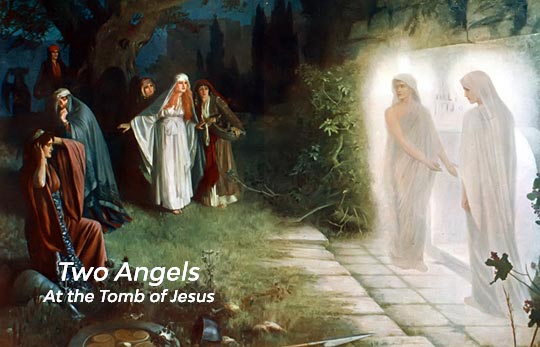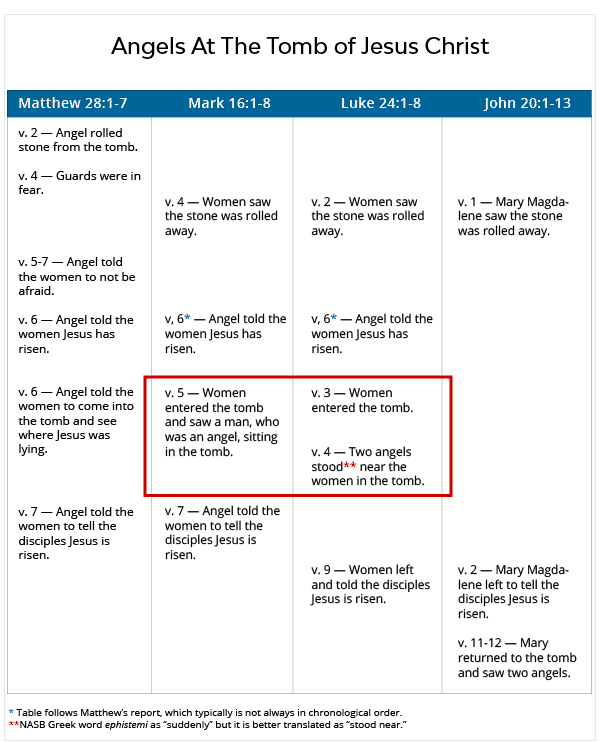Bible Question:
Matthew 28:2 says there was only one angel at the tomb of Jesus, while Mark 16:5 there was one young man clothed in a long white garment. Luke 24:4 and John 20:12 tells us there were two angels at the tomb. So who is right?
Bible Answer:
The gospels of Matthew and Mark refer to angel in their description of the events that occurred at the tomb after Jesus was resurrected. In contrast, Luke and John refer two angels . Consequently, some have concluded that the gospels are in disagreement. That is, some believe two of the gospels are wrong. Therefore, the questions this article will answer are, “Were there one or two angels at the tomb?” “How many angels were at the tomb?” Or, was there only one angel at the tomb?

Character of the Four Gospels
A comparison of the four gospels of Matthew, Mark, Luke and John reveals that they did not coordinate their reports. In fact, a careful reading of the gospels reveals that they included different information. That is, the authors of the four gospels did not choose to include the exact same information. As a result, their gospels appear to be different, but exclusion or inclusion of specific material does not mean they are wrong. The Holy Spirit had different purposes in mind when He moved the writers to write (2 Peter 1:20-21; 2 Timothy 3:16-17). Matthew presents his material topically, not chronologically. Mark is usually very brief or ignores a great amount of information. Luke is the most complete and presents his material in a chronological order. The gospel of John is not as brief as Mark and is less complete than Luke.
How Many Angels At The Tomb? — Matthew and Mark
If we compare the information from the gospels together, we learn that Mark reports that three women, Mary Magdalene, Mary the mother of James, and Salome came to the tomb to anoint Jesus.
When the Sabbath was over, Mary Magdalene, and Mary the mother of James, and Salome, bought spices, so that they might come and anoint Him. Mark 16:1 (NASB)
Luke 24:1 says the women came early. The accounts of Matthew, Mark and Luke focus primarily on the events inside the tomb. But the gospel of John focuses on Mary Magdalene and two disciples, ignoring the other women. Apparently, he does this to focus on Mary, the one who went to the disciples and told them that Jesus was resurrected. Mark, Luke and John tell us that when the women arrived they saw the stone that had already been rolled away. Only Matthew tells us an angel rolled the stone from the opening of Jesus’ tomb.
And behold, a severe earthquake had occurred, for an angel of the Lord descended from heaven and came and rolled away the stone and sat upon it. Matthew 28:2 (NASB)
Matthew and Mark focus on one angel, but Luke and John refer to two angels. Mark 16:5 says the angel, to whom he was referring, was wearing a white robe. Matthew 28:3 adds that he appeared as lightning and his clothes were white as snow.
And his appearance was like lightning, and his clothing as white as snow. Matthew 28:3 (NASB)
Since this angel is the one who rolled away the stone from the opening of the tomb (Matthew 28:1-5), it appears he was the lead angel. He is also the angel who spoke to the three women who came to the tomb (Matthew 28:5-7; Mark 16:6-7; Luke 24:5-7).
Matthew 28:6 reports that the angel told the women that Jesus was already risen.
He is not here, for He has risen, just as He said. Come, see the place where He was lying. Matthew 28:6 (NASB)
But Mark (Mark 16:6) and Luke (Luke 24:6) mention this information later in their accounts. This is not an error or discrepancy. Matthew was just less concerned about presenting events in chronological order. This is true of the gospel of Matthew; events are not always presented in chronological order.
When Mark says the women found a man sitting inside the tomb, he was the same angel that Matthew mentions. When angels appear in human form, Scripture always refers to angels as males. It is obvious that he is an angel since he knows that Jesus is risen and where He was going.

How Many Angels At The Tomb? — Luke and John
While Matthew and Mark refer to one angel at the tomb, the gospels of Luke and John refer to two angels.
While they were perplexed about this, behold, two men suddenly stood near them in dazzling clothing . . . Luke 24:4 (NASB)
But Mary was standing outside the tomb weeping; and so, as she wept, she stooped and looked into the tomb; and she saw two angels in white sitting, one at the head and one at the feet, where the body of Jesus had been lying. John 20:11-12 (NASB)
In Luke 24:4, the NASB says that two angels “suddenly stood.” But a better translation is “stood nearby” as evidenced by the ESV, HCSB, KJV and the NKJV. The Greek word is ephistemi. That is, the two angels stood nearby. At first, the women had seen only one angel, the one mentioned in Matthew and Mark. Then they saw the second angel. Since Luke is more detailed, we can thank God for his details. This means that one of these two angels was the one in Matthew and Mark, and then the second angel that Luke and John include did not speak. Apparently, that may have been why Matthew and Mark ignored the second angel.
In contrast to Matthew, Mark and Luke, the gospel of John ignores everything that occurred inside the tomb earlier and focuses only on Mary Magdalene’s visit to the two disciples, Peter and John and their subsequent visit at the tomb. The gospel of John does refer to two angels that Mary saw upon her return to the tomb. He also mentions Mary’s return to the tomb and her interaction with Jesus.
Conclusion
In conclusion, there are no conflicts between the four gospels of Matthew, Mark, Luke and John. The differences between them are due to the facts that each gospel chose to ignore as they presented the facts they wanted to emphasize. The variations that we see reveal that the writers gave four independent accounts of the resurrection events. The chart above provides the sequence of event as presented by the four gospels. If they had been in perfect agreement, critics would accuse them of copying each other. Once again, we see that apparent conflicts in Scripture are only apparent. The information between the gospels is not in conflict.
Suggested Links:
Angels – Good and EvilCan fallen angels look like humans? – What can demons look like?
Does the Bible say there are male and female angels?
How many angels are there?
Why did God create angels?
Who resurrected Jesus from the dead?